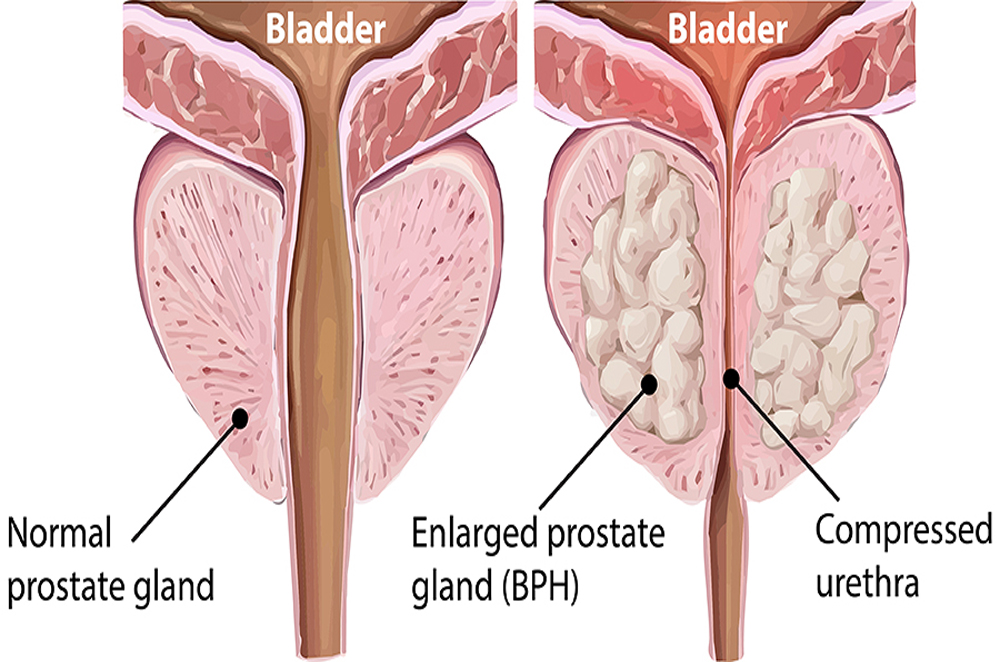
The prostate is a small organ normally about the size of a walnut. It lies below the bladder (where urine is stored) and surrounds the urethra (the tube that carries urine from the bladder to the exterior). Prostate gland makes a fluid that helps in nourishment of sperm as part of the semen (ejaculatory fluid). Prostate related problems are common in men of age 50 and older. An urologist is a specialist in diseases of the genitourinary system, including diagnosing and treating all the problems related to prostate gland for example age related increase in size of the prostate called as BPH to more complex and malignant condition like prostatic cancer as well. .
What is Benign Prostatic Hyperplasia?
Benign prostatic hyperplasia (BPH) is non-malignant (noncancerous) enlargement of the prostate gland, a common occurrence in older men. It generally evolves slowly, and commonly causes symptoms after age 50 though rarely a cause of symptoms in younger age group.
Signs and symptoms of benign prostatic hyperplasia
- Frequent Urination
- Sensation of Incomplete emptying of bladder
- Nocturia (Getting up multiple times in night to pass urine during sleep)
- Dribbling at the end of your urinary stream
- Incontinence, or leakage of urine
- A sudden strong desire to pass urine
- A slowed or delayed urinary stream
- Painful urination
- Blood in the urine
Complications of benign prostatic hyperplasia
- Sudden inability to urinate (urinary retention).
- Urinary tract infections (UTIs).
- Bladder stones.
- Bladder damage.
- Kidney damage.
The size of your prostate doesn't necessarily determine the severity of your symptoms. Some men with only slightly enlarged prostates can have significant symptoms, while other men with very enlarged prostates can have only minor or no urinary symptoms.
Investigation for Prostate
- USG of KUB : Ultrasound of the Kidneys, ureters and urinary bladder along with prostate is a valuable basic screening scan that helps to understand the size of the prostate along with the status of other parts of urinary tract and it's abnormalities. Also, it helps in assessing prevoid and postvoid urine volumes.
- Urinalysis : Your urine is checked for blood, bacteria, sugar in case of Diabetics and Proteins in patients with longstanding kidney disease.
- Urodynamic test : This blood test is a marker which helps in detection of cancer of prostate gland. It's a organ specific marker and not disease specific so it can be deranged in other non cancerous conditions as well like Prostatic infections, Inability to pass urine (Urinary retention) due to various reasons, Foley catheter insertion (Tube put to drain urine), any instrumentation or interventions involving urinary tract.
- Uroflowmetry (UFR-PVR) test : While doing this test, when patient gets a normal desire to pass urine, he/she is asked to pass urine in a container which is connected to a machine, showing the urinary flow details and then immediately post void residue is also checked to assess the volume of urine left behind in the bladder after one has completed urination.
- Prostatic biopsy : A small amount of prostate tissue is removed under guidance with the help of a needle and it's examined under microscopy for abnormalities.
- Cystoscopy: This is an examination of meatus, urethra including prostate and bladder with a tiny lighted scope that is inserted into urinary passage leading to the interior of the bladder. This can be a diagnostic procedure for assessing the lower urinary tract or done at the time of therapeutic intervention like TURP.
- Intravenous pyelography or urography: This is an X-ray exam or CT scan that is done after a dye is injected into your body. The dye highlights your entire urinary system involving Kidney ureters and bladder on the images produced by the X-ray or CT. Assessing the impact of obstruction created by the prostate gland on the upper urinary tract comprising kidneys and ureters.
Treatment Procedures of benign prostatic hyperplasia
Transurethral resection of the prostate (TURP) can be used for patients for whom benign prostatic hyperplasia (BPH) severely affects day today life even on medical management. TURP is a commonly used endoscopic surgical treatment during which a surgeon inserts a instrument called resectoscope into the urethra. The resectoscope is a tool that allows a Uro-surgeon to remove the enlarged prostate gland part. It is actually done by passing an electrical current through the cutting loop which is attahced to the resectoscope it cuts off small pieces of the prostate gland in “chips.” After finishing cutting away the prostatic chips, the surgeon will flush the urethra and the bladder to remove the tissue that has been extracted from the prostate. Finally, a catheter is inserted to allow the passage of urine out of the body. When the catheter is removed a few weeks later, the body has a wider channel to pass urine out of the body. This wider passage alleviates severe symptoms of BPH.
HOLEP Procedureare It's a minimally invasive surgical procedure used to treat BPH. HoLEP uses a laser to remove obstructive prostate tissue, providing relief from urinary symptoms associated with BPH. It's considered an effective treatment option with fewer complications compared to traditional surgical method like TURP.
Thulium Laser Enucleation of the Prostate (ThuLEP) is also a minimally invasive surgical technique used to BPH. It involves using a thulium laser to precisely remove the obstructive prostate tissue. This procedure has gained popularity due to its effectiveness in relieving BPH symptoms while minimizing complications and recovery time.
Transurethral incision of the Prostate (TUIP) is an endoscopic surgical procedure used to treat benign prostatic hyperplasia in men. It involves making small incisions in the prostate gland to relieve the compression on the urethra and improve the flow of urine. TUIP is often considered an an option for men with relatively smaller prostate glands or less severe symptoms compared to TURP or other more invasive procedures.

